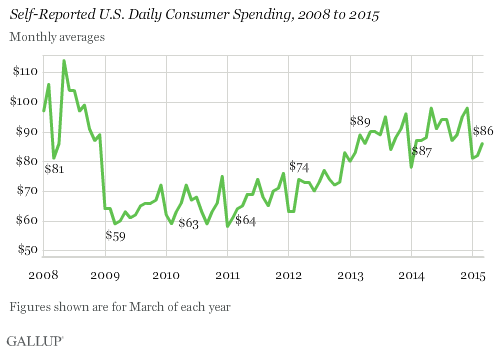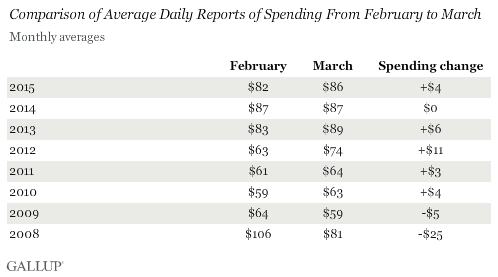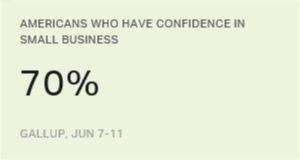Story Highlights
- Consumer spending averaged $86 in March
- The March average is $4 more than in February
- Spending in March 2015 is level with March 2014
WASHINGTON, D.C. -- In March, Americans' daily self-reports of spending averaged $86, level with the March 2014 average of $87, but below the averages for many months in 2014. Last month's figure, however, is up slightly from February's $82.

Each day, Gallup asks Americans to estimate the total amount they spent "yesterday" in restaurants, gas stations, stores or online -- not counting home and vehicle purchases, or normal monthly bills -- to provide an indication of Americans' discretionary spending. The March 2015 average is based on Gallup Daily tracking interviews with 15,708 U.S. adults.
After dropping in January, as usual after the holiday season, consumer spending remained at that lower level in February. The $4 increase in March is consistent with the slight increases seen in March of every year since 2010, with the exception of last year, when spending rose in February but was flat in March. Average daily spending dropped between February and March 2008 (by $25); however, that most likely was a sign of the looming recession.

Spending Increases Slightly Among Americans of All Income Groups
Average self-reports of spending in March increased by $7 among upper-income Americans -- those with annual household incomes of $90,000 a year or more -- to reach $144. Among middle- and lower-income Americans, those with incomes that are less than $90,000, spending increased by $4 from February to reach $75 in March. Last month's spending among middle- and lower-income Americans -- who make up the bulk of U.S. consumers -- was the same as in March 2014, while spending among upper-income Americans was down slightly compared with the previous year.

Implications
Despite dips in the Economic Confidence Index over the last few weeks of March, Americans' discretionary spending rose slightly over February levels. Average gas prices, which dropped rapidly last fall, were higher in March than earlier in the year, and this may have contributed to increased spending. The broad trend shows spending recovering after reaching lows during the Great Recession and its aftermath, but for the first months of 2015, spending has been lower than it was for most months last year. The March increase in spending compared with February's average could, however, be a good sign for the U.S. economy in the months to come.
The data in this article are available in Gallup Analytics.
Survey Methods
Results for this Gallup poll are based on telephone interviews conducted March 1-31, 2015, on the Gallup U.S. Daily survey, with a random sample of 15,708 adults, aged 18 and older, living in all 50 U.S. states and the District of Columbia. For results based on the total sample of national adults, the margin of sampling error is ±1 percentage point at the 95% confidence level. The margin of error for the spending mean is ±$4. All reported margins of sampling error include computed design effects for weighting.
Each sample of national adults includes a minimum quota of 50% cellphone respondents and 50% landline respondents, with additional minimum quotas by time zone within region. Landline and cellular telephone numbers are selected using random-digit-dial methods.
Learn more about how Gallup Daily tracking works.

